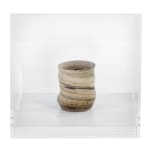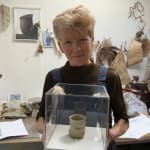Jennifer Lee
Mashiko 50-19, 2019-2020
Perspex cube, ceramic, coloured Japanese stoneware, oxides
20x20x20cm
Copyright The Artist
Sold
Jennifer Lee is an award-winning and highly regarded ceramic artist who has her works in the permanent collections of The Metropolitan Museum of Art, Philadelphia Museum of Art, Los Angeles...
Jennifer Lee is an award-winning and highly regarded ceramic artist who has her works in the permanent collections of The Metropolitan Museum of Art, Philadelphia Museum of Art, Los Angeles County Museum, British Museum and Victoria & Albert Museum.
Lee works in elemental materials, combining clay, water and oxides. In the past six years she has spent time working in Japan; invited by Issey Miyake to exhibit at his foundation, she showcased her pots within an installation by Tadao Ando.
Lee works in elemental materials, combining clay, water and oxides. In the past six years she has spent time working in Japan; invited by Issey Miyake to exhibit at his foundation, she showcased her pots within an installation by Tadao Ando.



